Related Research Articles

The National Firearms Act (NFA), 73rd Congress, Sess. 2, ch. 757, 48 Stat. 1236 was enacted on June 26, 1934, and currently codified and amended as I.R.C. ch. 53. The law is an Act of Congress in the United States that, in general, imposes an excise tax on the manufacture and transfer of certain firearms and mandates the registration of those firearms. The NFA is also referred to as Title II of the federal firearms laws, with the Gun Control Act of 1968 ("GCA") as Title I.

The Bureau of Alcohol, Tobacco, Firearms and Explosives (ATF), also referred to as BATFE, is a domestic law enforcement agency within the United States Department of Justice. Its responsibilities include the investigation and prevention of federal offenses involving the unlawful use, manufacture, and possession of firearms and explosives; acts of arson and bombings; and illegal trafficking and tax evasion of alcohol and tobacco products. The ATF also regulates via licensing the sale, possession, and transportation of firearms, ammunition, and explosives in interstate commerce. Many of the ATF's activities are carried out in conjunction with task forces made up of state and local law enforcement officers, such as Project Safe Neighborhoods. The ATF operates a unique fire research laboratory in Beltsville, Maryland, where full-scale mock-ups of criminal arson can be reconstructed. The agency is led by Marvin Richardson, Acting Director. Richardson previously served as the Associate Deputy Director and Chief Operating Officer, the second highest ranking official at ATF, from October 2019 to June 2021. The ATF has 5,101 employees and an annual budget of $1.274 billion (2019).

In the United States, a gun show is an event where promoters generally rent large public venues and then rent tables for display areas for dealers of guns and related items, and charge admission for buyers. The majority of guns for sale at gun shows are modern sporting firearms. Approximately 5,000 gun shows occur annually in the United States.
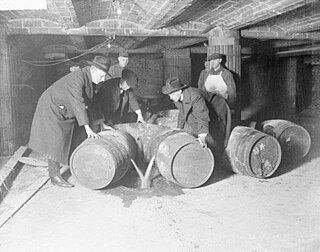
The Bureau of Prohibition was the United States federal law enforcement agency formed to enforce the National Prohibition Act of 1919, commonly known as the Volstead Act, which enforced the 18th Amendment to the United States Constitution regarding the prohibition of the manufacture, sale, and transportation of alcoholic beverages. When it was first established in 1920, it was a unit of the Bureau of Internal Revenue. On April 1, 1927, it became an independent entity within the Department of the Treasury, changing its name from the Prohibition Unit to the Bureau of Prohibition. In 1930, it became part of the Department of Justice. By 1933, with the repeal of Prohibition imminent, it was briefly absorbed into the FBI, or "Bureau of Investigation" as it was then called, and became the Bureau's "Alcohol Beverage Unit," though, for practical purposes it continued to operate as a separate agency. Very shortly after that, once repeal became a reality, and the only federal laws regarding alcoholic beverages being their taxation, it was switched back to Treasury, where it was renamed the Alcohol Tax Unit.

The Firearm Owners' Protection Act (FOPA) of 1986 is a United States federal law that revised many provisions of the Gun Control Act of 1968.
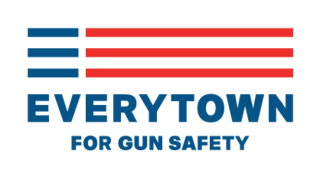
Everytown for Gun Safety is an American nonprofit organization which advocates for gun control and against gun violence. Everytown was created in 2013 when Mayors Against Illegal Guns and Moms Demand Action for Gun Sense in America joined forces.
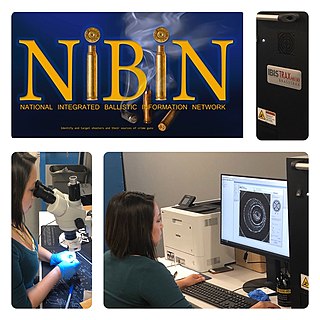
The National Integrated Ballistic Information Network or NIBIN is a specialized computer network in the United States. It contains digital images of recovered pieces of ballistic evidence.

Title II weapons, or NFA firearms, are designations of certain weapons under the United States National Firearms Act (NFA).

The Mérida Initiative is a security cooperation agreement among the United States, the government of Mexico and the countries of Central America, with the declared aim of combating the threats of drug trafficking, transnational organized crime and money laundering. The assistance includes training, equipment and intelligence.
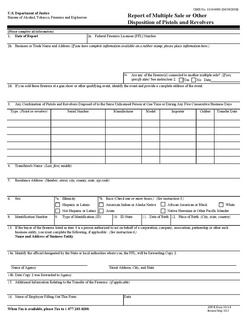
Report of Multiple Sale or Other Disposition of Pistols and Revolvers, or ATF Form 3310.4, is a form prescribed by the Bureau of Alcohol, Tobacco, Firearms, and Explosives (ATF) for use by firearm dealers holding a Federal Firearms License (FFL) to report when an unlicensed person purchases or acquires two or more handguns at one time or during five consecutive business days.

Violent Crime Impact Teams (VCIT) in the United States work proactively to identify, disrupt, arrest and prosecute the most violent criminals through innovative technology, analytical investigative resources and an integrated federal, state and local law enforcement strategy along with the leading federal law enforcement agency for the VCIT, the Bureau of Alcohol, Tobacco, Firearms and Explosives (ATF).
Project Gunrunner is a project of the U.S. Bureau of Alcohol, Tobacco, Firearms and Explosives (ATF) intended to stem the flow of firearms into Mexico, in an attempt to deprive the Mexican drug cartels of weapons.
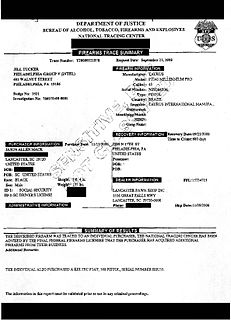
eTrace is an Internet-based firearm trace request submission system, developed by the United States' federal government, Bureau of Alcohol, Tobacco, Firearms and Explosives, that provides for the electronic exchange of traced firearm data in a secure internet-based environment. Participating law enforcement agencies with access to the internet can acquire 24/7 real-time capabilities to electronically submit firearm trace requests, monitor the progress of traces, retrieve completed trace results, and to query firearm trace related data in Bureau of Alcohol, Tobacco, Firearms and Explosives (ATF) firearms registration database at the National Tracing Center. Firearms tracing is the systematic tracking of the movement of a firearm from its creation by the manufacturer or its introduction into U.S. commerce by the importer, through the distribution chain to the first retail purchase. Release 4.0, a bilingual version of eTrace was deployed in December, 2009 for the benefit of Spanish-speaking countries.
The National Tracing Center (NTC) of the Bureau of Alcohol, Tobacco, Firearms and Explosives (ATF) is the sole firearms tracing facility in the United States. It provides information to provide foreign (international), federal, state and local law enforcement agencies with suspects for firearm crime investigations, detect suspected firearms traffickers, and track the intrastate, interstate and international movement of firearms. Congressional restrictions are in place to prevent the release of firearms trace information to anyone other than law enforcement agencies, however, this restriction does not apply to participating foreign countries or agencies. The only restriction is by Memorandum of Understanding (MOU) signed by the agency receiving ATF's eTrace software.
The U.S. Bomb Data Center serves as a nationwide collection center for information regarding arson and explosives related events throughout the United States. The Center was established in 1996 as a result of a congressional mandate and utilizes information from various government organizations such as the Bureau of Alcohol, Tobacco, Firearms and Explosives; the Federal Bureau of Investigation; and the United States Fire Administration.
The Tiahrt Amendment is a provision of the U.S. Department of Justice 2003 appropriations bill that prohibits the National Tracing Center of the Bureau of Alcohol, Tobacco, Firearms and Explosives (ATF) from releasing information from its firearms trace database to anyone other than a law enforcement agency or prosecutor in connection with a criminal investigation. This precludes gun trace data from being used in academic research of gun use in crime. Additionally, the law blocks any data legally released from being admissible in civil lawsuits against gun sellers or manufacturers.
The State of Texas is considered to have some of the most relaxed gun laws in the United States. Public concerns over gun control in Texas have increased in recent years as Mexican drug cartels continue to commit violent crimes closer to Texas' stretch of the Mexico–United States border. They have also increased due to the number of incidents, including misuse of firearms stolen from other sources.
Mexicans have a right to own firearms, but legal purchase from the single Mexican gun shop in Mexico City, controlled by the Army, is extremely difficult. Guns smuggled into Mexico are sometimes obtained at gunshops in the United States and carried across the US-Mexico border. In other cases the guns are obtained through Guatemalan borders or stolen from the police or military. Consequently, black market firearms are widely available. Many firearms are acquired in the U.S. by women with no criminal history, who transfer their purchases to smugglers through relatives, boyfriends and acquaintances who then smuggle them to Mexico a few at a time. The most common smuggled firearms include AR-15 and AK-47 type rifles, and FN 5.7 caliber semi-automatic pistols. Many firearms are purchased in the United States in a semi-automatic configuration before being converted to fire as select fire machine guns. Mexico seized in 2009 a combined total of more than 4,400 firearms of the AK-47 and AR-15 type, and 30% of AK-47 type semi-automatic rifles seized have been modified as select fire weapons.

The U.S. Federal Government is an opponent of the illegal drug trade; however, state laws vary greatly and in some cases contradict federal laws.
A privately made firearm, sometimes called ghost gun or homemade firearm, is a firearm that lacks a commercially-applied serial number. The term is used mostly in the United States by gun control advocates, but it is increasingly being used by gun rights advocates and some in the firearm industry. Because home-manufacture of firearms for personal use is not considered to fall under the U.S. federal government's authority to regulate interstate, as opposed to intrastate, commerce per the Commerce Clause, individuals making their own firearms are not subject to federal or state commercial background check regulations. Persons otherwise prohibited from owning firearms under the Gun Control Act of 1968 are still legally barred from the manufacture, transfer, or possession of firearms or ammunition, regardless of the method of manufacture or acquisition.
References
- 1 2 3 4 "Crime Gun Trace Analysis Reports: The Illegal Youth Firearms Markets in 17 Communities (Executive Summary)" (PDF). Bureau of Alcohol, Tobacco, Firearms and Explosives. 1997.
- ↑ "Crime Gun Trace Reports (2000) National Report". Bureau of Alcohol, Tobacco, Firearms and Explosives.